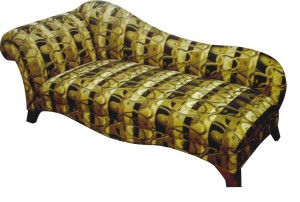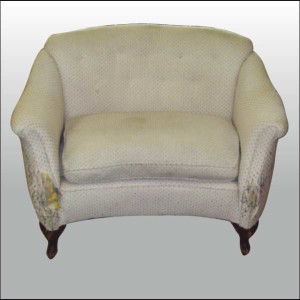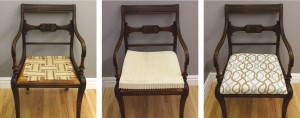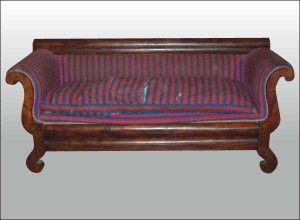Sound Bones
14 Jan 2015
Consider reupholstering furniture when it starts showing its age. It not only benefits the environment, it could improve your health.
By Lisa Marshall before-and-after photos courtesy lombardi upholstery
 After years of searching in vain for a trigger for her son’s frequent rashes and asthma attacks, Jacqueline Noel vowed to create a fresh start when she moved into her new Niwot home last year.
Inspired by the book My House Is Killing Me! The Home Guide for Families with Allergies and Asthma by Jeffrey C. May, she used low-VOC paints while remodeling, swapped out glue-infused carpeting for wood floors and hand-knotted rugs, and purged the house of synthetic chemical detergents and cleansers. When she went shopping for a new couch, she even insisted on a floor model—assuming it had already outgassed any lingering chemicals left over from manufacturing. But she was wrong.
“We brought our new couch into the house and my son had the worst asthma attack he’s ever had in his life,” Noel says. “So we went without furniture for a while.”
Since then, Noel has swapped out roughly 80 percent of the furniture in her home, replacing it with eco-friendly reincarnations she crafted with the help of artist and upholsterer Georgia English, who owns The Upholstery Shop in Lyons. By rehabbing dusty family heirlooms and vintage thrift-store finds with nontoxic materials, the pair has kept countless chairs and couches out of the landfill. And the benefits to Noel’s family have been plentiful.
“My son is off inhalers and steroids, and my house looks fabulous,” Noel says.
After years of searching in vain for a trigger for her son’s frequent rashes and asthma attacks, Jacqueline Noel vowed to create a fresh start when she moved into her new Niwot home last year.
Inspired by the book My House Is Killing Me! The Home Guide for Families with Allergies and Asthma by Jeffrey C. May, she used low-VOC paints while remodeling, swapped out glue-infused carpeting for wood floors and hand-knotted rugs, and purged the house of synthetic chemical detergents and cleansers. When she went shopping for a new couch, she even insisted on a floor model—assuming it had already outgassed any lingering chemicals left over from manufacturing. But she was wrong.
“We brought our new couch into the house and my son had the worst asthma attack he’s ever had in his life,” Noel says. “So we went without furniture for a while.”
Since then, Noel has swapped out roughly 80 percent of the furniture in her home, replacing it with eco-friendly reincarnations she crafted with the help of artist and upholsterer Georgia English, who owns The Upholstery Shop in Lyons. By rehabbing dusty family heirlooms and vintage thrift-store finds with nontoxic materials, the pair has kept countless chairs and couches out of the landfill. And the benefits to Noel’s family have been plentiful.
“My son is off inhalers and steroids, and my house looks fabulous,” Noel says.

 She is among a small but growing number of home decorators turning to furniture eco-rehabbing in the wake of alarming revelations about the health hazards of modern home furnishings. In 2012, Duke University researchers published a study showing 85 percent of U.S. couches contain foam pads treated with potentially hazardous fire retardants. Older couches were likely to contain polybrominated diphenyl ethers (PBDEs), which were recently phased out due to their association with neurobehavioral problems.
Newer pieces were likely to contain chlorinated tris, a flame retardant and a suspected carcinogen banned from children’s sleepwear in the 1970s but still ubiquitous in furniture foam. Other furniture chemicals were linked to hyperactivity, allergies and learning disabilities. An accompanying study noted that such chemicals easily escape our furniture cushions and find their way into house dust, where they are ingested or inhaled and enter the bloodstream.
She is among a small but growing number of home decorators turning to furniture eco-rehabbing in the wake of alarming revelations about the health hazards of modern home furnishings. In 2012, Duke University researchers published a study showing 85 percent of U.S. couches contain foam pads treated with potentially hazardous fire retardants. Older couches were likely to contain polybrominated diphenyl ethers (PBDEs), which were recently phased out due to their association with neurobehavioral problems.
Newer pieces were likely to contain chlorinated tris, a flame retardant and a suspected carcinogen banned from children’s sleepwear in the 1970s but still ubiquitous in furniture foam. Other furniture chemicals were linked to hyperactivity, allergies and learning disabilities. An accompanying study noted that such chemicals easily escape our furniture cushions and find their way into house dust, where they are ingested or inhaled and enter the bloodstream.
 Fire retardants aren’t the only worry. According to the nonprofit Natural
Fire retardants aren’t the only worry. According to the nonprofit Natural  Resources Defense Council, fabrics are often treated with formaldehyde-based resins (known skin and eye irritants) to guard against wrinkling and stains. Wood lacquers can contain chemical solvents that irritate eyes, skin and lungs, and cause headaches. Glues present in particleboard and furniture joints can trigger headaches. Leather is often tanned and dyed with a toxic brew. Even vintage, chemical-free furniture can be riddled with allergenic dust or mold spores.
“There is really no barrier between us and our furniture. We sit and lie on it all day and these things get on us,” says English, a Johns Hopkins-trained artist whose shop specializes in creating healthy, eco-friendly revisions of used furniture.
Resources Defense Council, fabrics are often treated with formaldehyde-based resins (known skin and eye irritants) to guard against wrinkling and stains. Wood lacquers can contain chemical solvents that irritate eyes, skin and lungs, and cause headaches. Glues present in particleboard and furniture joints can trigger headaches. Leather is often tanned and dyed with a toxic brew. Even vintage, chemical-free furniture can be riddled with allergenic dust or mold spores.
“There is really no barrier between us and our furniture. We sit and lie on it all day and these things get on us,” says English, a Johns Hopkins-trained artist whose shop specializes in creating healthy, eco-friendly revisions of used furniture.
Fanning the Flames
In recent years, health and environmental concerns have begun to catch the ear of lawmakers, prompting a slew of new regulations that could lead to healthier furniture. In 2013, an HBO exposé titled Toxic Hot Seat alleged that not only are fire retardants in furniture hazardous to health, they fail to prevent fires. As a result of such concerns, the state of California recently lifted a 40-year-old requirement that furniture sold in the state be treated with fire retardants, and dozens of states have begun rolling out legislation to either ban the chemicals outright or require that furniture including them be labeled. Meanwhile, companies like Cisco Brothers and Crate and Barrel have begun marketing flame-retardant–free furniture, and others, like Williams-Sonoma and Ikea, have promised to do so in 2015.
 Still, English and Noel point out, not everyone can afford to go out and buy new furniture. And even if they did, what would they do with their old stuff? (According to the Environmental Protection Agency, Americans already throw out 11.5 million tons of furniture each year).
“If you take an older piece and rehab it, you can use padding that isn’t full of chemicals, avoid toxic glues, choose eco-friendly fabrics, and keep it out of the landfill,” English says. “Plus, you can have a lot of fun with it.”
Here’s how to get started, English says:
Buy a used piece, or redo your own vintage furnishings. Look for a chair or couch with a silhouette you like, and submit it to the sit test and the smell test. If it has springs sticking up or hanging down, that’s fixable, English says. But if it wobbles, that’s a different story. “If a piece has been structurally damaged inside, that can be very hard to fix.”
Avoid anything that smells like mold or chemicals, and shoot for solid hardwood only, not particleboard. If the piece was made prior to 1975, consider testing it for lead in the paint. (A test kit can be purchased for about $12 at a hardware store).
Still, English and Noel point out, not everyone can afford to go out and buy new furniture. And even if they did, what would they do with their old stuff? (According to the Environmental Protection Agency, Americans already throw out 11.5 million tons of furniture each year).
“If you take an older piece and rehab it, you can use padding that isn’t full of chemicals, avoid toxic glues, choose eco-friendly fabrics, and keep it out of the landfill,” English says. “Plus, you can have a lot of fun with it.”
Here’s how to get started, English says:
Buy a used piece, or redo your own vintage furnishings. Look for a chair or couch with a silhouette you like, and submit it to the sit test and the smell test. If it has springs sticking up or hanging down, that’s fixable, English says. But if it wobbles, that’s a different story. “If a piece has been structurally damaged inside, that can be very hard to fix.”
Avoid anything that smells like mold or chemicals, and shoot for solid hardwood only, not particleboard. If the piece was made prior to 1975, consider testing it for lead in the paint. (A test kit can be purchased for about $12 at a hardware store).

- This redo by The Upholstery Shop in Lyons incorporated natural cotton webbing and a fire-retardant–free latex cushion covered in eco-friendly fabric.

 Get help. A professional upholsterer can help with some, or all, of your project. If you prefer to do it yourself, take a class.
Noel was so inspired by her son’s improved health that she is now teaming up with English to host a series of workshops on how to remove toxins from your furniture. The first is titled “Fabulous Green Furniture: How to Easily Upgrade Your Furniture Using Nontoxic Standards and Fabulous Eco-friendly Materials.” The workshop is on Saturday, Jan. 24, from 10a.m.-2p.m. at The Upholstery Shop, 401 Main St., Lyons. (See www.theupholsteryshopco.com for other offerings.)
Someday, Noel says, she and English may launch their own nontoxic furniture line.
“Even in a place like Boulder it’s still really hard to find, and it shouldn’t be,” she says. “I feel very passionate about this. When I look at my son and see how well he is doing, it keeps me going on this mission.”
Get help. A professional upholsterer can help with some, or all, of your project. If you prefer to do it yourself, take a class.
Noel was so inspired by her son’s improved health that she is now teaming up with English to host a series of workshops on how to remove toxins from your furniture. The first is titled “Fabulous Green Furniture: How to Easily Upgrade Your Furniture Using Nontoxic Standards and Fabulous Eco-friendly Materials.” The workshop is on Saturday, Jan. 24, from 10a.m.-2p.m. at The Upholstery Shop, 401 Main St., Lyons. (See www.theupholsteryshopco.com for other offerings.)
Someday, Noel says, she and English may launch their own nontoxic furniture line.
“Even in a place like Boulder it’s still really hard to find, and it shouldn’t be,” she says. “I feel very passionate about this. When I look at my son and see how well he is doing, it keeps me going on this mission.” 











